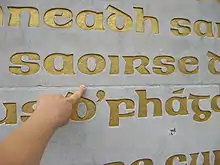
The Garden of Remembrance (Irish: An Gairdín Cuimhneacháin) is a memorial garden in Dublin dedicated to the memory of "all those who gave their lives in the cause of Irish Freedom". It is located in the northern fifth of the former Rotunda Gardens in Parnell Square, a Georgian square at the northern end of O'Connell Street.[1] The garden was opened by President Eamon de Valera during the semicentennial of the Easter Rising in 1966.[2]
Commemoration


The Garden commemorates freedom fighters from various uprisings, including:
- the 1798 rebellion of the Society of United Irishmen
- the 1803 rebellion of Robert Emmet
- the 1848 rebellion of Young Ireland
- the 1867 rising of the Fenian Brotherhood
- the 1916 Easter Rising of the Irish Volunteers and the Irish Citizen Army
- the 1919–21 Irish War of Independence of the Irish Republican Army[3]
The site of the Garden is where the Irish Volunteers were founded in 1913, and where several leaders of the 1916 Rising were held overnight before being taken to Kilmainham Gaol. President Éamon de Valera opened the Garden in 1966 on the fiftieth anniversary of the 1916 Easter Rising, in which he had been a commander.[1]
Design
The Garden was designed by Dáithí Hanly. It is in the form of a sunken cruciform water-feature. Its focal point is a statue of the Children of Lir by Oisín Kelly, symbolising rebirth and resurrection, added in 1971,[1] cast in the Ferdinando Marinelli Artistic Foundry of Florence, Italy.
In 1976, a contest was held to find a poem which could express the appreciation and inspiration of this struggle for freedom. The winner was Dublin-born author Liam Mac Uistín, whose poem "We Saw a Vision", an aisling style poem, is written in Irish, French, and English on the stone wall of the monument. The aisling ("vision") form was used in eighteenth-century poems longing for an end to Ireland's miserable condition.
"We Saw A Vision"
In the darkness of despair we saw a vision,
We lit the light of hope and it was not extinguished.
In the desert of discouragement we saw a vision.
We planted the tree of valour and it blossomed.
In the winter of bondage we saw a vision.
We melted the snow of lethargy and the river of resurrection flowed from it.
We sent our vision aswim like a swan on the river. The vision became a reality.
Winter became summer. Bondage became freedom and this we left to you as your inheritance.
O generations of freedom remember us, the generations of the vision.[1]

In Irish the poem reads:
"An Aisling"
I ndorchacht an éadóchais rinneadh aisling dúinn.
Lasamar solas an dóchais agus níor múchadh é.
I bhfásach an lagmhisnigh rinneadh aisling dúinn.
Chuireamar crann na crógachta agus tháinig bláth air.
I ngeimhreadh na daoirse rinneadh aisling dúinn.
Mheileamar sneachta na táimhe agus rith abhainn na hathbheochana as.
Chuireamar ár n-aisling ag snámh mar eala ar an abhainn. Rinneadh fírinne den aisling.
Rinneadh samhradh den gheimhreadh. Rinneadh saoirse den daoirse agus d'fhágamar agaibhse mar oidhreacht í.
A ghlúnta na saoirse cuimhnígí orainne, glúnta na haislinge.
In 2004, it was suggested that as part of the redesign of the square the Garden of Remembrance itself might be redesigned. This led to the construction of a new entrance on the garden's northern side in 2007.
Queen Elizabeth II laid a wreath in the Garden of Remembrance during her state visit in May 2011, a gesture that was much praised in the Irish media, and which was also attended, upon invitation, by the widow and the daughter of the garden's designer Dáithí Hanly KHS.
References
- 1 2 3 4 5 Whelan, Yvonne (2001). "Symbolising the state: The iconography of O'Connell Street, Dublin after Independence (1922)". Irish Geography. 34 (2): 145–150. doi:10.1080/00750770109555784.
- ↑ Linehan, Hugh. "Remembering the Rising: how they did it in 1966". The Irish Times. Retrieved 2 April 2019.
- ↑ "Garden of Remembrance, Dublin". Tourist Information Dublin. Retrieved 23 November 2015.
See also
- Irish National War Memorial Gardens, to Irish soldiers who fought and died in Irish regiments of the Allied armies in World War I
 "We Saw a Vision" by Liam Mac Uistín
"We Saw a Vision" by Liam Mac Uistín "An Aisling" by Liam Mac Uistín
"An Aisling" by Liam Mac Uistín
